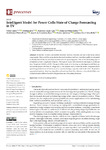Intelligent Model for Power Cells State of Charge Forecasting in EV

Ver/
Use este enlace para citar
http://hdl.handle.net/2183/31763
A non ser que se indique outra cousa, a licenza do ítem descríbese como Attribution 4.0 International (CC BY 4.0) https://creativecommons.org/licenses/by/4.0/
Coleccións
- GI-CTC - Artigos [75]
Metadatos
Mostrar o rexistro completo do ítemTítulo
Intelligent Model for Power Cells State of Charge Forecasting in EVAutor(es)
Data
2022-07-19Cita bibliográfica
López, V.; Jove, E.; Zayas Gato, F.; Pinto-Santos, F.; Piñón-Pazos, A.J.; Casteleiro-Roca, J.-L.; Quintian, H.; Calvo-Rolle, J.L. Intelligent Model for Power Cells State of Charge Forecasting in EV. Processes 2022, 10, 1406. https://doi.org/10.3390/pr10071406
Resumo
[Abstract] In electric vehicles and mobile electronic devices, batteries are one of the most critical components. They work by using electrochemical reactions that have been thoroughly investigated to identify their behavior and characteristics at each operating point. One of the fascinating aspects of batteries is their complicated behavior. The type of power cell reviewed in this study is a Lithium Iron Phosphate LiFePO4 (LFP). The goal of this study is to develop an intelligent model that can forecast the power cell State of Charge (SOC). The dataset used to create the model comprises all the operating points measured from an actual system during a capacity confirmation test. Regression approaches based on Deep Learning (DL), such as Long Short-Term Memory networks (LSTM), were evaluated under different model configurations and forecasting horizons.
Palabras chave
LSTM
Forecasting
Battery
Forecasting
Battery
Versión do editor
Dereitos
Attribution 4.0 International (CC BY 4.0) https://creativecommons.org/licenses/by/4.0/
ISSN
2227-9717






